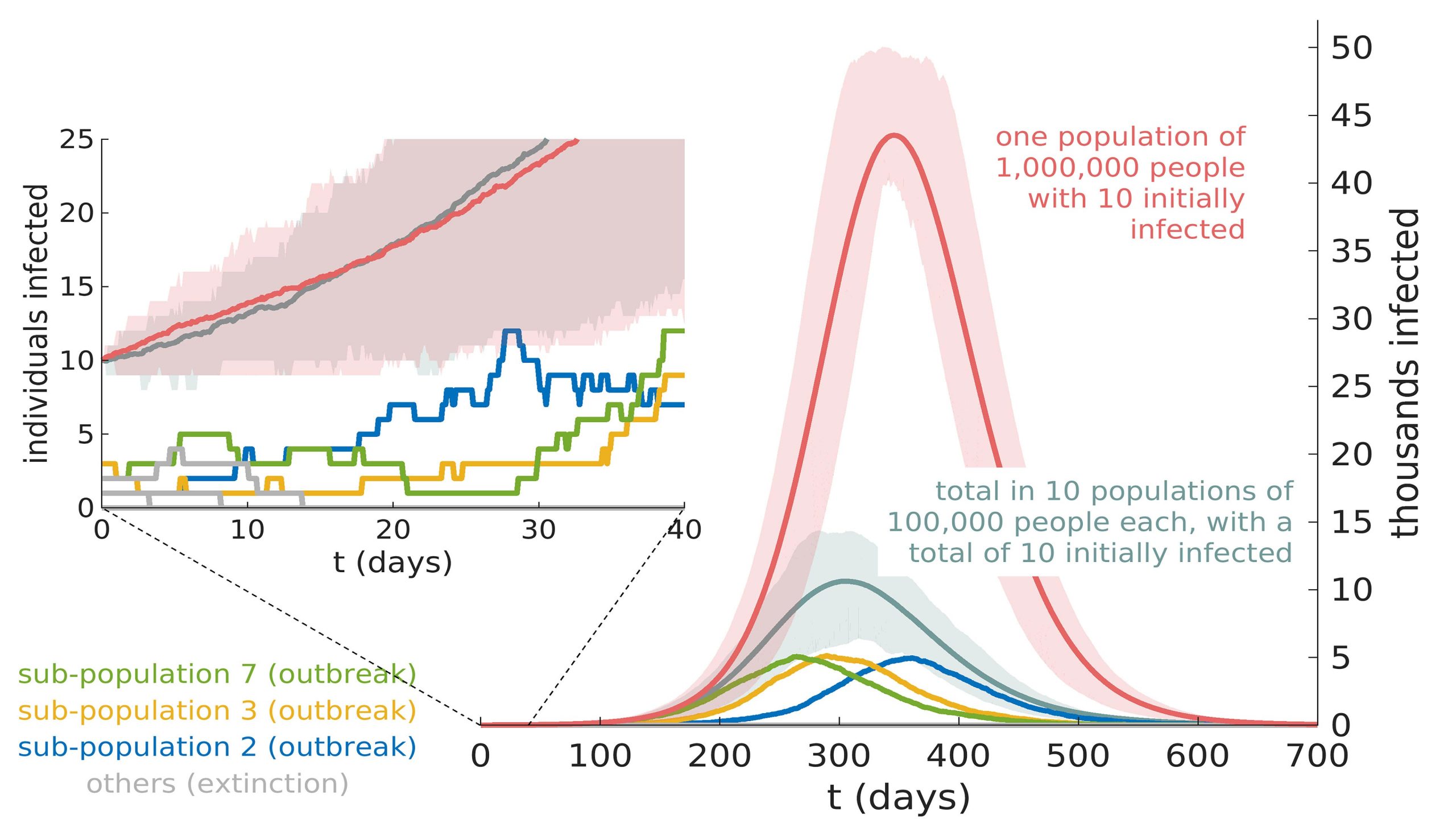Divide and Conquer: The red curve shows the effect of 10 infected people out of a population of 1 million people. When the population is divided into groups of 100,000 each, desynchronized outbreaks occur in three subpopulations (shorter colored curves). In the remaining seven subgroups, gray curve, the breakout is deleted. Photo credit: Philip Bittihn and Ramin Golestanian
The inherent randomness of contacts between infected and healthy individuals increases the benefit of dividing a population into smaller communities to combat epidemics.
In order to control an epidemic, the authorities often impose different levels of lockdown. In an article in the magazine chaosAt AIP Publishing, scientists used math and computer simulations to find why dividing a large population into multiple sub-populations that do not mix can help contain outbreaks without imposing contact restrictions within those local communities.
“The key idea is that fluctuations in low numbers of infections can significantly change the course of epidemics, even if, on average, an exponential increase in the number of infections is expected,” said author Ramin Golestanian.
When the infection numbers are high, random effects can be ignored. However, subdividing a population can create communities so small that the random effects play a role.
“When a large population is divided into smaller communities, these random effects completely change the dynamics of the population as a whole. The peak infection numbers are significantly reduced by chance, ”said author Philip Bittihn.
To find out how randomness affects an epidemic, the researchers first looked at what is known as a deterministic model with no random events. For this test, they assumed that individuals in each sub-population encounter others at the same rate as in the large population. Although subpopulations are not allowed to mix, the same dynamics are observed in the subdivided population as in the initially large population.
However, if random effects are included in the model, dramatic changes result, although the contact rate in the subpopulations is the same as in the full one.
A population of 8 million individuals with 500 initially infected individuals was examined using an infectious contact rate observed COVID-19 with mild social distancing measures. With these parameters, the disease spreads exponentially, with infections doubling every 12 days.
“If this population is allowed to mix homogeneously, the dynamics will develop according to the deterministic prediction with a peak of about 5% infected people,” said Bittihn.
However, if the population is divided into 100 subpopulations of 80,000 people each, the peak percentage of infected people drops to 3%. If the community is further divided into 500 subgroups of 16,000 each, the infection will only reach 1% of the original population.
The main reason for the division of the population work is that the epidemic has been completely wiped out in a significant part of the subgroups. This “extinction effect” occurs when chains of infection end spontaneously.
Another way to subdivide is to desynchronize the entire population. Even when outbreaks occur in the smaller communities, the peaks can occur at different times and cannot be synchronized and add up to a large number.
“In reality, subpopulations cannot be perfectly isolated, so local extinction may only be temporary,” Golestanian said. “Further studies are ongoing to consider these and appropriate countermeasures.”
Reference: “Stochastic Effects on the Dynamics of an Epidemic Due to Population Division” by Philip Bittihn and Ramin Golestanian, October 27, 2020, chaos.
DOI: 10.1063 / 5.0028972



